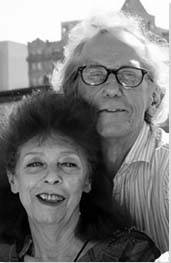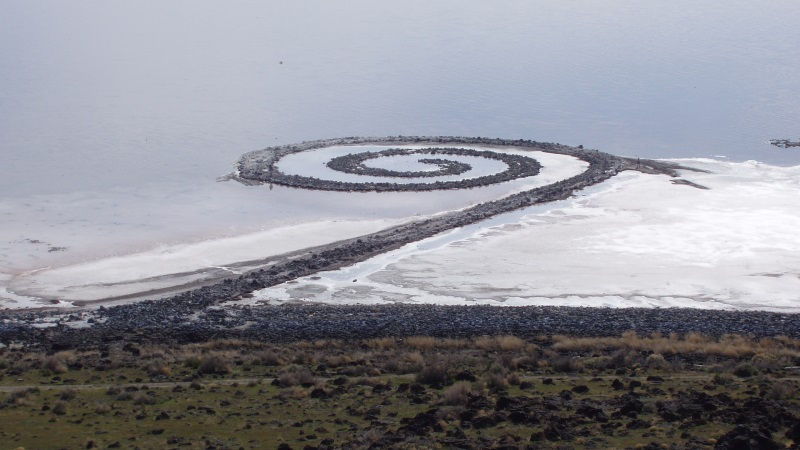Summary of Christo and Jeanne-Claude
Christo's early education in Soviet Socialist Realism, and his experience fleeing his home as a refugee of political revolution, informed his career's numerous forays into real-world politics as a primary subject and source of his artmaking. His 35-year collaboration with his wife and fellow artist, Jeanne-Claude, and the large-scale installation works they co-authored, stand out as some of the greatest achievements in early site-specific art. Together, the duo created monumentally-scaled sculptures and interventions which often utilized the technique of draping or wrapping large portions of existent landscapes, buildings, and industrial objects with specially engineered fabric. While they often insisted that the aesthetic properties of their art constituted its primary value, reactions from audiences and critics worldwide have long recognized a broader commentary operating across their work, and themes ranging from environmental degradation, to the vexed history of the 20th century and the Cold War, to the perseverance of democratic and humanist ideals.
Accomplishments
- Christo and Jeanne-Claude's interventions in the natural world and the built environment altered both the physical form and the visual experience of the sites, thereby allowing viewers to perceive and understand the locations with a new appreciation of their formal, energetic, and volumetric qualities.
- The artists' choice to remain intermittently inside and outside the frameworks of legality lends much of their work a built-in aspect of dissent and resistance. It also expands upon and emboldens a long legacy of quasi-legality in art, where art exists in a realm somewhere between the "real" world and fantasy, and affords the art world with distinct privileges as well as restrictions.
- Christo and Jeanne-Claude often worked outside the gallery system, refusing to negotiate sales of drawings and commissions through an art dealer. In this respect, they took a definitive stance on the political and economic infrastructure of the global art market, and set a precedent for artists working outside the system who still cultivated an international level of success.
- Whereas Land Artists usually made a point of blurring the lines of distinction between the art work itself and its natural setting and/or materials, Christo and Jeanne-Claude's art relied on developing high contrast between the engineered, man-made elements and the site's organic characteristics. Their work therefore pushes the envelope of what constitutes site-specific, large-scale installation art, and expands the genre discourse to incorporate controversial themes of industrialization, bureaucratization, and late capitalism.
The Life of Christo and Jeanne-Claude
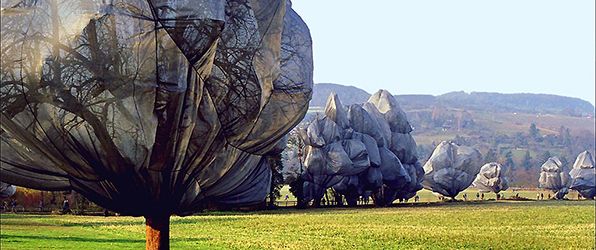
Born on the same day (to the hour), but countries and cultures apart, husband and wife Christo and Jeanne-Claude worked together for decades as a true artistic team, taking on monumental, site-specific installation projects that made them key figures in the Environmental art movement.
Important Art by Christo and Jeanne-Claude
Wall of Oil Barrels - Rideau de Fer (The Iron Curtain)
Christo and Jeanne-Claude's first collaborations involved wrapping dozens of oil barrels with cloth and rope, and stacking them in layers across public spaces so as to partially or completely block access. Earlier iterations of this site-specific work on Rue Visconti in Paris included a version in the courtyard of Christo's studio, as well as 1961's Stacked Oil Barrels and Dockside Packages, both of which were installed for two weeks on the harbor in Cologne, Germany. Particularly in Wall of Oil Barrels, the artists expanded the scope and scale of the previous works, creating a larger and more impenetrable wall of both wrapped and unwrapped barrels that blockaded a section of a city street. Christo was propelled by the idea of spatially reconfiguring a specific outdoor location with a common, contextually misplaced object, a notion that would play a role in many of his future creations and collaborations with Jeanne-Claude.
The piece utilized 89 barrels, and measured 13.2 feet wide, 2.7 feet deep, and 13.7 feet tall. It took eight hours to assemble. An expression of the artists' views on the disruptive nature of the Cold War and the Berlin Wall, which was then in the process of being built, Wall of Oil Barrels commented on the politics of space, freedom, and mobility under increasingly conservative and divisive governmental policies throughout Europe. Since they installed it without permission, Parisian authorities demanded that the piece be dismantled, but Jeanne-Claude was able to persuade them to allow the work to remain in place for several hours. This monumental work and its brief celebrity as a public nuisance helped Christo and Jeanne-Claude gain early notoriety in Paris.
Oil barrels became an important medium for Christo in 1958. He had previously been utilizing smaller, everyday, affordable objects like beer cans, but the barrels initiated a significant shift towards larger works, while still adhering to a distinct type of sculptural form. Wall of Oil Barrels was Christo's first large scale work, and marked the beginning of the collaborative, massively scaled, site-specific works for which he and Jeanne-Claude would become famous.
Rue Visconti, Paris
Wrapped Coast
Using one million square feet of erosion-control synthetic fabric, 35 miles of polypropylene rope, 25,000 fasteners, threaded studs, and clips, Christo and Jeanne-Claude wrapped 1.5 miles of rocky coast off Little Bay in Sydney, Australia to create Wrapped Coast in the late 1960s. This method of wrapping was something that Christo had experimented with previously, using smaller objects, but this monumental effort became the largest single artwork ever created at the time, surpassing Mount Rushmore. It remained wrapped for ten weeks, beginning October 28, 1969.
The draping of the fabric over the coast helped to re-contextualize and de-familiarize a well-known natural setting, and revealed the essential form and shape of the coast as a discrete object in and of itself. Passersby experienced a shift in their commonplace perspective of the landscape by having limitations - both visual and physical - imposed upon the viewing process. This selective imposition also brought about new and unexpected revelations about the nature of the coastline, particularly its formal and structural qualities as a cohesive object with a distinct shape, substance, and volume.
Little Bay, Sydney, Australia
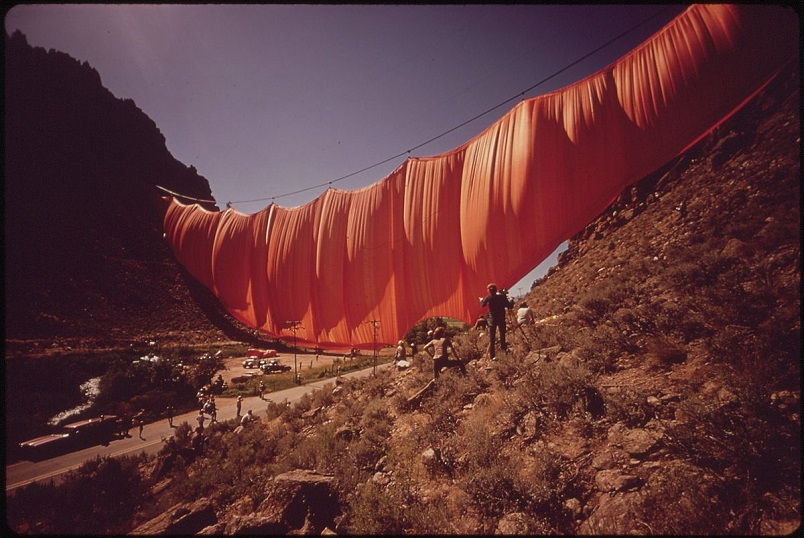
Valley Curtain
In the Spring of 1970 Christo and Jeanne-Claude began work on Valley, a 200 x 200 square foot section of orange, woven nylon fabric that stretched across an entire Colorado valley. The gigantic, crescent-shaped fabric was suspended on a steel cable and anchored to two mountain tops, between Grand Junction and Glenwood Springs in the Hogback Mountain Range. It was tied down with 27 ropes, and spread across the valley at a maximum measurement of 1,250 feet wide and 365 feet high.
Valley Curtain was a tremendous feat of engineering and coordination that experienced significant and expensive setbacks. Christo and his team first attempted to install the curtain on October 9, 1971, but a gust of wind caught the fabric and it flew away, ripping on the surrounding rocks and construction equipment. On August 19, 1972 it was at last erected successfully, but it remained intact for only 28 hours, until a wind at over 60 miles per hour threatened to tear through it once more. Workers dismantled the piece shortly thereafter.
For the brief time that it was in place, the bright orange drape slung between the craggy mountains reinvigorated the valley's contours, highlighting its natural flow, rhythm, and volume. Like many of the duo's large-scale environmental works, it brought new perspective to a familiar landscape, and encouraged a refreshed appreciation of the natural world. The bold color of the fabric popped against the bright sky, the muted blue mountains in the distance, and the greenery covering the nearby hills. Few viewers were able to see it live in its short, 28-hour existence, which added to the work's sense of fragility, vulnerability, and urgency, while also stimulating an awareness of the emptiness that accompanied its eventual dismantling. The work was documented extensively in photographs: ultimately, the most prolific medium of earth works, these types of works which are purposely subjected to environmental change, impermanence, and decay.
Rifle, Colorado
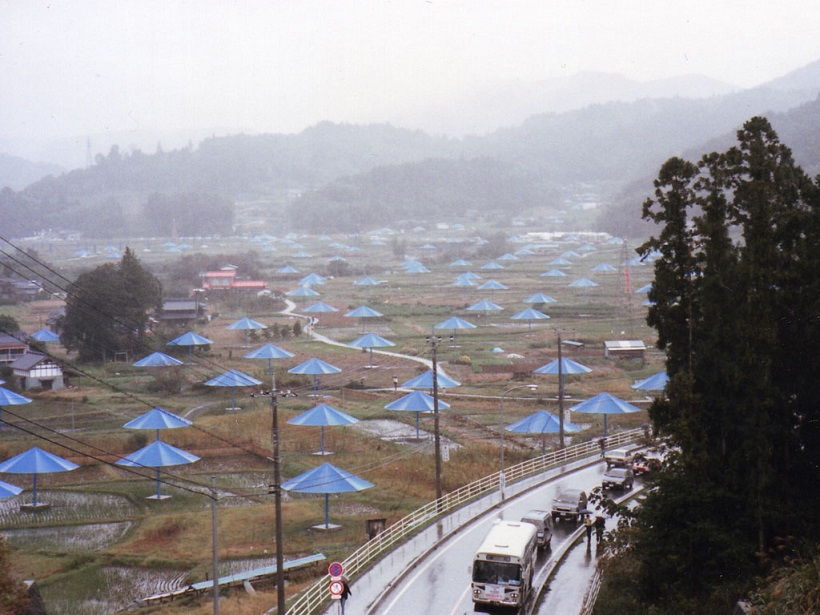
The Umbrellas
This piece took place simultaneously in two different rural locations, one in Japan outside the city of Tokyo, and the other in California north of Los Angeles. The umbrellas were assembled in California and composed of fabric, aluminum, steel, wooden supports, bags, and molded base covers. Each umbrella was 19 feet high and 28 feet wide. 1,340 blue umbrellas were installed in Japan, a color chosen to evoke the rich vegetation and water resources of the area, and 1,760 yellow umbrellas were placed in California, reflecting the golden grass that covers the nearby grazing hills. In Japan, the umbrellas were placed closer together following the geometry of the rice fields, and they were spread further out in California, where vast expanses of agricultural land dominate much of the Central Valley. The usage of umbrellas in each location symbolizes the similarities and the differences associated with the ways of life and the land usage in each area. They represented the varied availability and character of the land, and the temporary cycles of cultivation wrought by human industry.
After years of preparation and planning, environmental studies, wind tests, and negotiations, the first steel bases went down December 1990. The exhibit was finally unveiled on October 9, 1991, and received about 3 million visitors. It became a huge tourist attraction and a popular site for picnics and weddings. The work quickly turned controversial, however, when one umbrella caught a strong wind and pinned a woman against a rock, ultimately killing her and injuring three others. The project was cited for removal and during the dismantling process, a Japanese worker was electrocuted when an umbrella he was holding hit an electrical wire. Some critics responded to these tragic accidents by taking umbrage with the egocentrism of Christo and Jeanne-Claude's spectacle-oriented, massively scaled visual productions, and subsequent projects became more difficult for the artists to find financial and governmental backing.
Joint Project for Japan and USA
Wrapped Reichstag
This work used 1,076,390 square feet of thick, shiny, aluminum-based polypropylene fabric and 9.7 miles of blue polypropylene rope to wrap the Reichstag in Germany. The relief faces, towers, and the roof of the building were covered with 70 panels of fabric shaped and designed specifically for the facade, while the rest was draped in large swaths of the fabric. The silvery cloth and blue ropes that outlined the building highlighted the distinctive features of the architecture.
Christo first sketched out the idea for wrapping a building in 1961, and envisioned early on that a public government building with a strong link to the general populace would be the preferred site. Years later, he identified the Reichstag as the perfect building to wrap, because it represented the possibility of a renewed relationship between Europe's Eastern and Western blocs. The Reichstag originally opened in 1894 and was the seat of the German parliament until 1933 when it was damaged in a fire. The building went through immediate renovations, but was not completely restored until after Christo's project was realized. His wrapping and unveiling came to coincide closely with the completion of the renovations in 1995, and so the work symbolically alluded to the rebuilding of Germany after World War II and the fall of the Soviet Union. It also recalled vexed attempts by the government to "cover up" the country's tumultuous past.
Wrapped Reichstag took over 24 years to be realized. The German government turned down the proposal three separate times, in 1977, 1981, and again in 1987. In 1993, the president of the German parliament Rita Sussmuth finally announced her support for the project, and after another year of discussion, a majority parliamentary vote gave Christo and Jeanne-Claude the go-ahead in 1994. Christo and Jeanne-Claude's political battles paved the way for future artists to find expressive possibility in bureaucratic systems.
The artists' use of fabric recalled classical traditions of representing space and bodies in voluminous, carefully modeled pleats, folds and drapes. In Wrapped Reichstag, the artists nodded to this tradition by draping fabric over form, but revised it in a modern, charged, political statement.
Project for Berlin
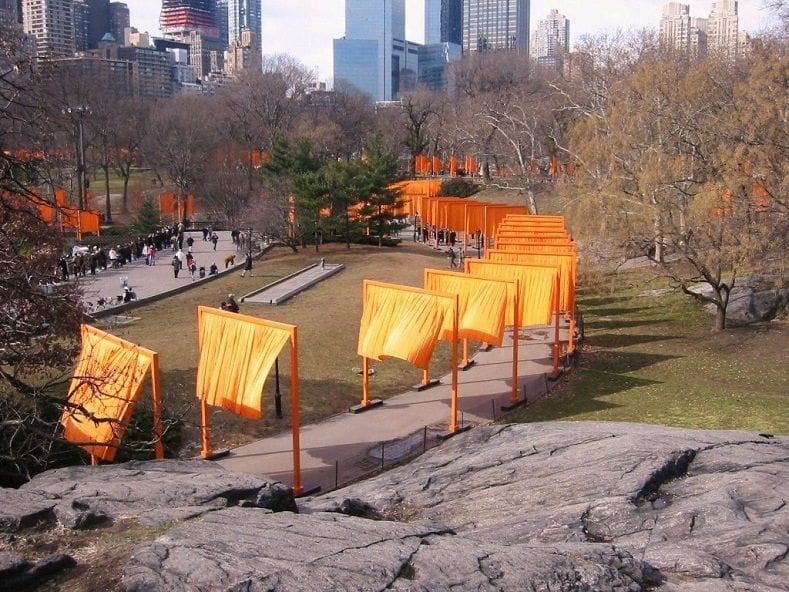
The Gates
This work consisted of 7,503 gates made of a free-flowing vinyl fabric in a saffron color. Each gate was 16 feet tall, and varied in width from 5 to 18 feet wide. The fabric pieces were hung about seven feet above the ground, and the supports were spaced 12 feet from each other, except for certain spots where tree branches impeded the fabric's ability to flap freely in the wind. The gates spanned 23 miles of Central Park's walkways, appearing and disappearing through the trees like a river, weaving and diverting its flow along the existent park features. The rectangular forms of the fabric reflected the angular grid of city blocks of New York, while their movement in the wind spoke to the organic elements of the city and the fluid motion of millions of people along its regularized, urban grid. From the vantage point of the skyscrapers overlooking the park, the gates had the distinct visual effect of looking like an orange river, snaking through Central Park. To some viewers inside the park, however, the Gates did not accentuate the park experience, but stood out like a sore thumb. The work's relationship to the natural landscape was lost on some and evocative for others, but in either case, drew a large amount of attention and response.
The Gates was in its incubation and development stages from 1970 to 1981, when city officials first turned it down. Michael Bloomberg, a close friend of the artists, was elected mayor of New York City in 2002. His election was the turning point that paved the way for the proposal's eventual greenlighting in 2005. Bloomberg called the piece "one of the most exciting public art projects ever put on anywhere in the world," and awarded the couple with the Doris C. Freedman Award for Public Art. The Gates resembled other works of environmental or "land art" of the 1970s, and for this reason was seen by some as outdated and inconsequential, and a failure by the artists to create a piece that spoke to the current political and cultural mood.
Central Park, New York
Biography of Christo and Jeanne-Claude
Childhood and Education
Christo Vladimirov Javacheff was born in Gabrovo, Bulgaria, a small town in the Balkan Mountains. His parents were Ivan Vladimir Javacheff, a chemist and a businessman who ran a fabric factory, and Tzveta Dimitrova, a political activist and a secretary at the Academy of Fine Arts in Sofia, Bulgaria. Ivan and Tzveta were socially connected with artists and intellectuals around Gabrovo, and Christo grew up surrounded by progressive ideas and culture.
Christo began creating art early on, inspired by his parents' bohemian social circle, and was encouraged by several professors from the Academy of Fine Arts who would frequent the family home to visit his parents. Politics also shaped his early life, and as a young boy Christo witnessed his birth country's invasion by the Nazis, and later by the Soviets.
Jeanne-Claude Denat de Guillebon was born in Morocco, where her father, Major Léon Denat, a French general, was stationed. Her young mother, Précilda, divorced her father not long after she was born, and went on to re-marry three times. The military family moved around quite a bit, and she received most of her early education in France and Switzerland. She was, from the start, an outgoing, highly social person with strong organizational skills.
Jeanne-Claude earned a degree in Latin and Philosophy from the University of Tunis in 1952 , the same year that Christo enrolled at the Fine Art Academy in Sofia, where he studied and worked until 1956. The curriculum at the academy focused mainly on Soviet Socialist Realism, a government-mandated style of artistic production that was developed in the early-20th century in the Soviet Union as a specifically non-capitalist form of populist art. Christo also became involved in a campus Communist Youth group, where he assisted in creating propaganda posters in line with the tenets and techniques of Socialist Realist political art.
After he graduated from the academy, Christo left for Prague, Czechoslovakia. There he forayed into theater design, and studied with the Burian Theatre, where he was first exposed to the work of Matisse, Miró, Klee, and Kandinsky. During his first year in Prague, the Hungarian Revolution broke out in 1956, a situation that became particularly dangerous for students and members of the artistic and intellectual classes. Christo fled Hungary by bribing a railway worker to stow him away on a train transporting medicines and medical supplies. He made it safely to Vienna, Austria, but the move forced him to lose his Bulgarian citizenship and become known as a "stateless person," a UN designation initiated in 1954 to manage the mass refugee crisis following World War II. He stayed briefly in Vienna, studying sculpture at the Academy of Fine Arts under the artist Wotruba for one semester.
Early Period
Christo then relocated to Geneva for one year, and then on to Paris in 1958, where he met Jeanne-Claude when he was commissioned to paint a portrait of her mother. At the time, Jeanne-Claude was engaged to a man named Philippe Planchon. However, it is believed that shortly before her wedding, Jeanne-Claude became pregnant by Christo. The two had become very close very quickly upon learning that they were born within the same hour of one-another. Although Jeanne-Claude went through with the wedding to Planchon, she divorced him immediately after the honeymoon, and married Christo in October of that same year. Their son, Cyril, was born on May 11, 1960.
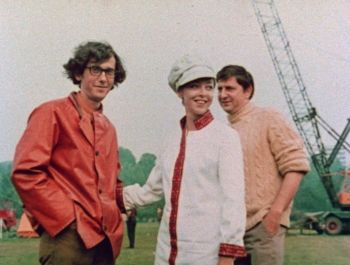
Christo's early years in Paris were not without difficulty, as he struggled to learn the language and assimilate into the culture. He made a living by painting portraits on the street, which he felt were not representative of his skill or true artistic identity, so he signed these under the name "Javacheff" rather than with his own. The couple made their first work together, a temporary installation consisting of oil drums, rolls of industrial paper, and tarpaulin wrapping, in 1961. The act of "wrapping" objects and buildings would become hallmarks of their work. By the mid-1960s, they were already gaining recognition as ground-breaking artists. During their years in Paris, they met Arman, Daniel Spoerri, Jean Tinguely, and Yves Klein, all artists associated with the Nouveau Realisme movement in which the objects and materials of everyday life are directly appropriated and incorporated into multi-media works.
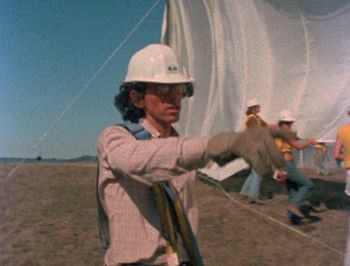
In 1964 the couple moved to New York City and lived as undocumented immigrants for three years, squatting in an illegal building that they eventually purchased in 1973 when Christo also became an American citizen. Christo created life-sized installations entitled Store Fronts and Show Windows, and sold these large-scale gallery works to help finance his other, less saleable projects, which included wrapping entire buildings in Italy and the U.S., and working with landscapes from the Australian coast to the mountain ranges of Colorado.
Later Period
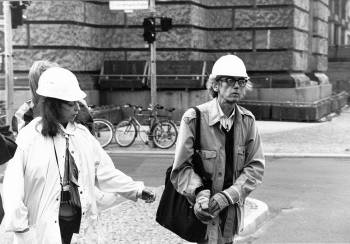
Jeanne-Claude was originally seen as Christo's publicist and business manager, but was later given due credit for her role as his creative and administrative partner. The pair emphasized that everything they created since the 1960s had been a dual effort, and for marketing purposes, they chose only to put Christo's name on their artwork. It wasn't until 1994 that they decided to attribute their outdoor works and large-scale temporary indoor installations to "Christo and Jeanne-Claude". The couple worked from their studio and home in New York, rarely hired assistants, and self-funded their projects through the sale of sketches, blueprints, and 3-D models. Their collaboration was so integral to their process that they often travelled on different planes to ensure that if one plane crashed, the other could continue to work on their joint projects.
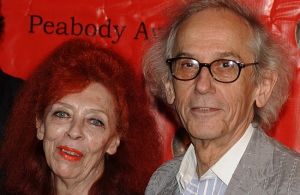
The couple were working on two simultaneous projects, Over the River in Colorado and The Mastaba in the United Arab Emirates, when Jeanne-Claude suffered from a brain aneurysm in 2009. She died from resulting complications on November 18, at the age of 74. Christo continued working toward the realization of their large-scale works until his own peaceful passing at his New York home at the age of 84.
The Legacy of Christo and Jeanne-Claude
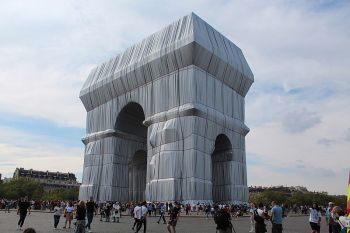
Christo and Jeanne-Claude's outdoor works are regarded as some of the most ambitious and innovative in the world, though they are oftentimes controversial due to their size and questionable impact on the environment. To address these controversies, the artists conducted thorough environmental impact studies and recycled every material that they expressly manufactured.
Aesthetic impact is the value that Christo and Jeanne-Claude emphasized as the most important, intended aspect of their work, yet the effect their work has had on the world far exceeds the merits of aesthetics alone. Their work pushes the boundaries of convention and categorization of art, in particular the notion of sculpture as a fixed, permanent object. Acting directly upon the environment, rather than at a contemplative remove from it, implies for some that their work is a commentary on notions ranging from freedom, to human agency, to the powerful impermanence of the natural world. Jeanne-Claude, in fact, likened their work to a rainbow, made all the more beautiful and exciting because it is temporary.
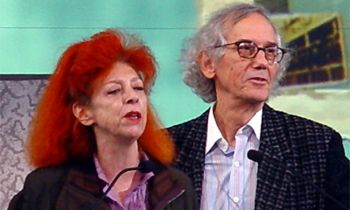
The couple's efforts have been recognized by filmmakers and photographers, and a 1973 documentary about their work was nominated for an Academy Award. In 2004, they won the Achievement in Contemporary Sculpture Award, and in 2006, they received the Best Project in a Public Space award for The Gates, as well as the Vilcek Prize in Fine Arts for foreigners working abroad.
Influences and Connections

-
![Arman]() Arman
Arman -
![Daniel Spoerri]() Daniel Spoerri
Daniel Spoerri -
![Jean Tinguely]() Jean Tinguely
Jean Tinguely -
![Yves Klein]() Yves Klein
Yves Klein ![Pierre Restany]() Pierre Restany
Pierre Restany
![Wolfgang Volz]() Wolfgang Volz
Wolfgang Volz![Albert and David Maysles]() Albert and David Maysles
Albert and David Maysles
![Dorothy and Herbert Vogel]() Dorothy and Herbert Vogel
Dorothy and Herbert Vogel
-
![Land Art]() Land Art
Land Art -
![Environmental Art]() Environmental Art
Environmental Art ![Public Sculpture]() Public Sculpture
Public Sculpture
Useful Resources on Christo and Jeanne-Claude
- Christo amd Jeanne-Claude: An Authorized BiographyOur PickBy Burt Chernow and Wolfgang Volz
- Christo and Jeanne-Claude: A BiographyBy Burt Chernow, and Wolfgang Volz
